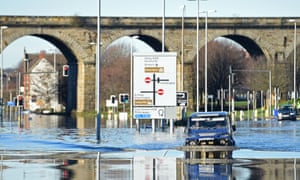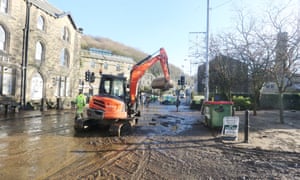Failed flood defences cast doubt on UK readiness for new weather era
An extra 1,000 soldiers are on standby as thousands of people are evacuated amid the threat of more heavy rain to come this week in northern England
Matthew Taylor, Ben Quinnand John Vidal
Monday 28 December 2015 05.13 GMTLast modified on Monday 28 December 201509.59 GMT
Britain’s ability to cope with the “unprecedented” flood crises that hit several urban centres simultaneously over the weekend has been called into question after the failure of key flood defences in the north led to thousands of homes being put at risk.
Three cities - York, Leeds and Manchester - were hit by the severe weather, alongside scores of towns and villages, forcing the evacuation of thousands in what David Cameron described as an unprecedented situation. The prime minister was expected to visit the stricken areas on Monday.
David Cameron: northern England flooding ‘incredibly serious situation’
With more heavy rain predicted for the middle of the week, the situation could worsen and an extra 200 troops have been dispatched to the worst-hit areas to join the 300 already helping communities cope with the flooding.
A Downing Street spokesperson said on Sunday night that a further 1,000 military personnel were on standby “should the situation worsen”.
More rain will batter the north of England on Wednesday with up to 80mm (3in) falling on high ground and as much as 120mm (4.7ins ) in exposed locations.
A motorist drives through the flood waters on Kirkstall Road in central Leeds on 27 December. Photograph: Paul Ellis/AFP/Getty Images
Amid warnings that climate change would lead to more frequent and severe flooding, the state of the large-scale defences was brought into sharp relief after pumping equipment in York was overwhelmed by the sheer volume of water.
In a move that apparently sacrificed some areas in order to prevent greater devastation elsewhere, officials decided at the weekend to raise the river Foss flood barrier in order to prevent it from becoming stuck. Hundreds of homes were evacuated and entire streets were submerged. York’s barrier, completed in 1987 following serious flooding in 1982, also experienced problems in 2012 when four of its eight pumps failed due to overheating, resulting in flood warnings for hundreds of householders.
Charlie Croft, from York City Council, confirmed on Monday morning that river waters in the city had peaked, telling the BBC: “We have to say that we are still in the middle of a major incident, though tentative positive news is that the river may now have stopped rising at this point.”
Floods continued to bring chaos to thousands of homes and businesses elsewhere across the north of England. In Leeds, main roads in the city centre remained under water. In Greater Manchester, 7,000 homes were still without power after rivers topped their banks.

A man searches through flood damaged property left in a car park in Rochdale. Photograph: Barbara Cook/Demotix/Corbis
While experts have cautioned that it is too early to give precise figures for the losses caused by Storm Desmond and Storm Eva, the accountancy firm PricewaterhouseCoopers said that an initial analysis showed that they could run as high as £1.3bn.
Facing questions about Britain’s readiness to cope with severe weather events after cuts to the government’s flood spending over the past five years, the environment secretary Liz Truss pledged that flood defences would be reviewed.
Shadow chancellor John McDonnell called for a cross-party consensus to ensure that investment in flood resilience does not fall victim to politics, while a council leader in a flood-hit part of Yorkshire said measures needed to extend beyond spending on major flood defence schemes. Mr McDonnell said he was ready to agree levels of spending on measures to adapt to climate change with chancellor George Osborne to ensure that investment continues whoever wins the next election.
Live UK floods: people told to waterproof homes because of increase in 'unknown extremes' - live
David Cameron to visit stricken areas across north of England as failed defences cast doubt on readiness for new weather era
Calderdale council leader Tim Swift said: “It’s just obvious that the scale of flooding events over the last 10 years has been dramatically greater than anything we’ve had before, and without getting into an argument, even if you put the most generous interpretation on what the government is doing, the level of flood resilience funding hasn’t increased to match that.
“One of the big questions we will be asking is what the most effective response is. We’re pretty clear it needs to be about the whole system. There is still a case for major flood defence schemes, but we also want to look at land management and drainage as well. Calderdale needs a comprehensive solution.
In York, where 3,500 homes were at risk near the rivers Ouse and Foss, there were calls for the state of flood defences and funding to be reviewed. Among the worst affected was the area around Huntingdon Road, close to the city centre, where vehicles and homes were partially submerged.
The clean up process begins in Hebden Bridge, West Yorkshire. Photograph: Barbara Cook/Demotix/Corbis
Problems arose at the weekend at the Foss barrier and pumping station, which controls river levels by managing the interaction between the rivers Foss and Ouse. In a model that is commonplace around the country, pumps behind the barrier are supposed to pump the water clear. The station became inundated with floodwater after the volume exceeded the capacity of the pumps and flooded some of the electrics, according to an Environment Agency spokesperson, who said that a helicopter was due to airlift in parts to complete repairs on Monday.
“The barrier gate was opened to let the river Foss flow into the river Ouse to prevent very high water levels in the Foss from backing up and creating dangerous levels of flooding, which would have created a serious risk to the public,” the spokesperson added.
Just before Christmas, the government published figures on flood spending levels over the past five years. They tumbled nearly 30% after 2010-11, and have only now picked up thanks to “exceptional” funding as a result of the 2013-14 floods. By 2014-15, capital investment on flood defences had fallen to £228m, supplemented by a further £125m.
Drone footage of flooding in the West Yorkshire towns of Hebden Bridge and Mytholmroyd.
Innes Thomson, a former flood chief at the Environment Agency who heads the Association of Drainage Authorities, whose job is to manage water levels and keep water flowing, called for more money to be spent on maintenance rather than on big new defence projects.

Flooding in northern England – in pictures
“If we were to spend more just maintaining and managing water levels, it would be money well spent,” he said. “If we spent a slug of money now cleaning up rivers, it would help. All sorts of work needs to be done. We have £22bn of flood risk assets, but [we need to ask] have we got the right standard? Are they in good condition? Should we upgrade our pumps? Do we need to ensure all our embankments are sound? Are our watercourses clear of obstacles? I think we are talking about tens of millions of pounds. Now is an opportunity to reconsider where we spend our money.”
More than 200 flood alerts and warnings were in place for England, Wales and Scotland on Sunday afternoon, including more than 20 severe warnings, indicating danger to life. Among the most seriously affected areas were Pennine towns between Leeds and Manchester that saw rivers hit record levels – up to 5ft above their previous peak in some places.
In Sowerby Bridge, West Yorkshire, hundreds of homes and businesses were flooded, with residents piling sodden furniture, Christmas presents and other belongings in the street. A few miles down the valley in Hebden Bridge, residents were coming to terms with their third devastating flood in the past four years.
Truss told the BBC: “Every single river [in Lancashire] was at a record high,” adding that in Yorkshire, some rivers were a metre higher than ever before. “Clearly in the light of that, we will be reviewing our flood defences.”
An extra 1,000 soldiers are on standby as thousands of people are evacuated amid the threat of more heavy rain to come this week in northern England
Matthew Taylor, Ben Quinnand John Vidal
Monday 28 December 2015 05.13 GMTLast modified on Monday 28 December 201509.59 GMT
Britain’s ability to cope with the “unprecedented” flood crises that hit several urban centres simultaneously over the weekend has been called into question after the failure of key flood defences in the north led to thousands of homes being put at risk.
Three cities - York, Leeds and Manchester - were hit by the severe weather, alongside scores of towns and villages, forcing the evacuation of thousands in what David Cameron described as an unprecedented situation. The prime minister was expected to visit the stricken areas on Monday.
David Cameron: northern England flooding ‘incredibly serious situation’
With more heavy rain predicted for the middle of the week, the situation could worsen and an extra 200 troops have been dispatched to the worst-hit areas to join the 300 already helping communities cope with the flooding.
A Downing Street spokesperson said on Sunday night that a further 1,000 military personnel were on standby “should the situation worsen”.
More rain will batter the north of England on Wednesday with up to 80mm (3in) falling on high ground and as much as 120mm (4.7ins ) in exposed locations.

A motorist drives through the flood waters on Kirkstall Road in central Leeds on 27 December. Photograph: Paul Ellis/AFP/Getty Images
Amid warnings that climate change would lead to more frequent and severe flooding, the state of the large-scale defences was brought into sharp relief after pumping equipment in York was overwhelmed by the sheer volume of water.
In a move that apparently sacrificed some areas in order to prevent greater devastation elsewhere, officials decided at the weekend to raise the river Foss flood barrier in order to prevent it from becoming stuck. Hundreds of homes were evacuated and entire streets were submerged. York’s barrier, completed in 1987 following serious flooding in 1982, also experienced problems in 2012 when four of its eight pumps failed due to overheating, resulting in flood warnings for hundreds of householders.
Charlie Croft, from York City Council, confirmed on Monday morning that river waters in the city had peaked, telling the BBC: “We have to say that we are still in the middle of a major incident, though tentative positive news is that the river may now have stopped rising at this point.”
Floods continued to bring chaos to thousands of homes and businesses elsewhere across the north of England. In Leeds, main roads in the city centre remained under water. In Greater Manchester, 7,000 homes were still without power after rivers topped their banks.

A man searches through flood damaged property left in a car park in Rochdale. Photograph: Barbara Cook/Demotix/Corbis
While experts have cautioned that it is too early to give precise figures for the losses caused by Storm Desmond and Storm Eva, the accountancy firm PricewaterhouseCoopers said that an initial analysis showed that they could run as high as £1.3bn.
Facing questions about Britain’s readiness to cope with severe weather events after cuts to the government’s flood spending over the past five years, the environment secretary Liz Truss pledged that flood defences would be reviewed.
Shadow chancellor John McDonnell called for a cross-party consensus to ensure that investment in flood resilience does not fall victim to politics, while a council leader in a flood-hit part of Yorkshire said measures needed to extend beyond spending on major flood defence schemes. Mr McDonnell said he was ready to agree levels of spending on measures to adapt to climate change with chancellor George Osborne to ensure that investment continues whoever wins the next election.
Live UK floods: people told to waterproof homes because of increase in 'unknown extremes' - live
David Cameron to visit stricken areas across north of England as failed defences cast doubt on readiness for new weather era
Calderdale council leader Tim Swift said: “It’s just obvious that the scale of flooding events over the last 10 years has been dramatically greater than anything we’ve had before, and without getting into an argument, even if you put the most generous interpretation on what the government is doing, the level of flood resilience funding hasn’t increased to match that.
“One of the big questions we will be asking is what the most effective response is. We’re pretty clear it needs to be about the whole system. There is still a case for major flood defence schemes, but we also want to look at land management and drainage as well. Calderdale needs a comprehensive solution.
In York, where 3,500 homes were at risk near the rivers Ouse and Foss, there were calls for the state of flood defences and funding to be reviewed. Among the worst affected was the area around Huntingdon Road, close to the city centre, where vehicles and homes were partially submerged.

The clean up process begins in Hebden Bridge, West Yorkshire. Photograph: Barbara Cook/Demotix/Corbis
Problems arose at the weekend at the Foss barrier and pumping station, which controls river levels by managing the interaction between the rivers Foss and Ouse. In a model that is commonplace around the country, pumps behind the barrier are supposed to pump the water clear. The station became inundated with floodwater after the volume exceeded the capacity of the pumps and flooded some of the electrics, according to an Environment Agency spokesperson, who said that a helicopter was due to airlift in parts to complete repairs on Monday.
“The barrier gate was opened to let the river Foss flow into the river Ouse to prevent very high water levels in the Foss from backing up and creating dangerous levels of flooding, which would have created a serious risk to the public,” the spokesperson added.
Just before Christmas, the government published figures on flood spending levels over the past five years. They tumbled nearly 30% after 2010-11, and have only now picked up thanks to “exceptional” funding as a result of the 2013-14 floods. By 2014-15, capital investment on flood defences had fallen to £228m, supplemented by a further £125m.
Drone footage of flooding in the West Yorkshire towns of Hebden Bridge and Mytholmroyd.
Innes Thomson, a former flood chief at the Environment Agency who heads the Association of Drainage Authorities, whose job is to manage water levels and keep water flowing, called for more money to be spent on maintenance rather than on big new defence projects.

Flooding in northern England – in pictures
“If we were to spend more just maintaining and managing water levels, it would be money well spent,” he said. “If we spent a slug of money now cleaning up rivers, it would help. All sorts of work needs to be done. We have £22bn of flood risk assets, but [we need to ask] have we got the right standard? Are they in good condition? Should we upgrade our pumps? Do we need to ensure all our embankments are sound? Are our watercourses clear of obstacles? I think we are talking about tens of millions of pounds. Now is an opportunity to reconsider where we spend our money.”
More than 200 flood alerts and warnings were in place for England, Wales and Scotland on Sunday afternoon, including more than 20 severe warnings, indicating danger to life. Among the most seriously affected areas were Pennine towns between Leeds and Manchester that saw rivers hit record levels – up to 5ft above their previous peak in some places.
In Sowerby Bridge, West Yorkshire, hundreds of homes and businesses were flooded, with residents piling sodden furniture, Christmas presents and other belongings in the street. A few miles down the valley in Hebden Bridge, residents were coming to terms with their third devastating flood in the past four years.
Truss told the BBC: “Every single river [in Lancashire] was at a record high,” adding that in Yorkshire, some rivers were a metre higher than ever before. “Clearly in the light of that, we will be reviewing our flood defences.”
No comments:
Post a Comment